
Cartmel Priory church serves as the parish church of Cartmel, Cumbria, England.

Peel towers are small fortified keeps or tower houses, built along the English and Scottish borders in the Scottish Marches and North of England, mainly between the mid-14th century and about 1600. They were free-standing with defence being a prime consideration of their design with "confirmation of status and prestige" also playing a role. They also functioned as watch towers where signal fires could be lit by the garrison to warn of approaching danger.

Appleby Castle is in the town of Appleby-in-Westmorland overlooking the River Eden. It consists of a 12th-century castle keep which is known as Caesar's Tower, and a mansion house. These, together with their associated buildings, are set in a courtyard surrounded by curtain walls. Caesar's Tower and the mansion house are each recorded in the National Heritage List for England as a designated Grade I listed building. The uninhabited parts of the castle are a scheduled ancient monument.
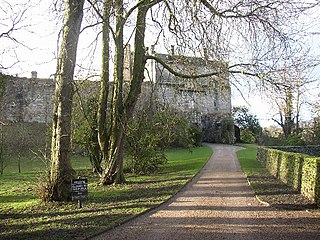
Cockermouth Castle is in the town of Cockermouth in Cumbria on a site by the junction of the Rivers Cocker and Derwent. It is a grade I listed building and a Scheduled Ancient Monument.

Kirklinton is a village in the Carlisle district, in the English county of Cumbria. The population of the civil parish of Kirklinton Middle, taken at the 2011 census was 384. It is a few miles away from the large village of Longtown. It has a church called St Cuthbert's Church. The parish contains the village of Smithfield.

Burneside Hall is a converted medieval pele tower in Burneside, Cumbria, England.

Arnside Tower is a late-medieval tower house between Arnside and Silverdale immediately to the south of Arnside Knott in Cumbria, England.
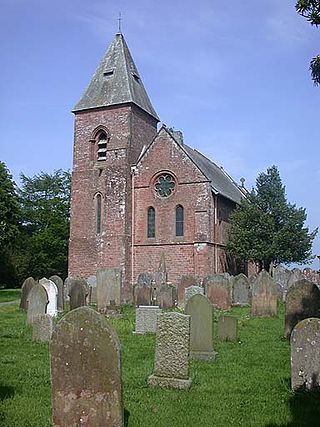
St Mary's Church is in the village of Walton, Cumbria, England. It is an active Anglican parish church in the deanery of Brampton, the archdeaconry of Carlisle, and the diocese of Carlisle. Its benefice is united with those of four nearby parishes. The church is recorded in the National Heritage List for England as a designated Grade II* listed building.

St Peter's Church is in the village of Mansergh, Cumbria, England. It is an active Anglican parish church in the deanery of Kendal, the archdeaconry of Westmorland and Furness, and the diocese of Carlisle. Its benefice is united with those of six local churches to form the Kirkby Lonsdale Team Ministry. The church is recorded in the National Heritage List for England as a designated Grade II listed building.
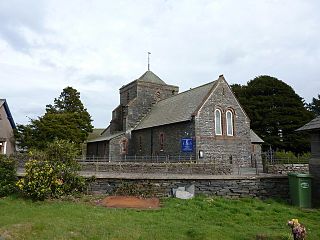
St Luke's Church is in the village of Torver, Cumbria, England. It is an active Anglican parish church in the deanery of Furness, the archdeaconry of Westmorland and Furness, and the diocese of Carlisle. The church is recorded in the National Heritage List for England as a designated Grade II listed building.

Cumbria is a county in North West England. It was created in 1974 from the historical counties of Westmorland and Cumberland, together with the Furness area of Lancashire and the Sedbergh Rural District of the West Riding of Yorkshire. Its largest settlement is the county town of Carlisle. Buildings in England are given listed building status by the Secretary of State for Culture, Media and Sport, acting on the recommendation of Historic England. Listed status gives the structure national recognition and protection against alteration or demolition without authorisation. Grade I listed buildings are defined as being of "exceptional interest, sometimes considered to be internationally important"; only 2.5 per cent of listed buildings are included in this grade.

St Mary's Church is in the town of Kirkby Lonsdale, Cumbria, England. It is an active Anglican parish church in the deanery of Kendal, the archdeaconry of Westmorland and Furness, and the diocese of Carlisle. Its benefice is united with those of six local churches to form the Kirkby Lonsdale Team Ministry. The church contains Norman architecture and is recorded in the National Heritage List for England as a designated Grade I listed building.

St Laurence's Church is in the village of Morland, Cumbria, England. It is an active Anglican parish church in the deanery of Appleby, the archdeaconry of Carlisle, and the diocese of Carlisle. Its benefice is united with those of St Mary, Thrimby, St Barnabas, Great Strickland, and St Cuthbert, Cliburn. The church is recorded in the National Heritage List for England as a designated Grade I listed building. It has the only Anglo-Saxon tower in Cumbria.
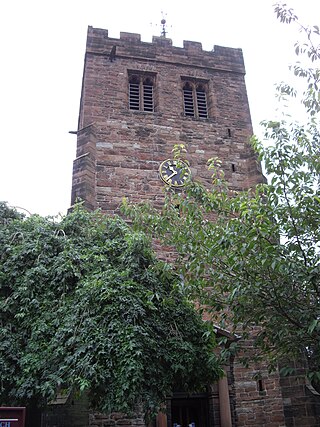
St Andrew's Church is in the centre of the town of Penrith, Cumbria, England. It is an active Anglican parish church in the deanery of Penrith, the archdeaconry of Carlisle, and the diocese of Carlisle. The parishes of Penrith ; St John, Newton Reigny and St John the Evangelist, Plumpton Wall are united in a single benefice. The church is recorded in the National Heritage List for England as a designated Grade I listed building. At one time St Andrew's had a chapel of ease or mission church in Brougham Street in the Penrith suburb of Castletown called St Saviours and another, All Hallows at the hamlet of Bowscar just to the north of the town.

St Oswald's Church is in the village of Ravenstonedale, Cumbria, England. It is an active Anglican parish church in the deanery of Appleby, the archdeaconry of Carlisle, and the diocese of Carlisle. Its benefice is united with those of All Saints, Orton, and St James, Tebay. The church is recorded in the National Heritage List for England as a designated Grade I listed building.
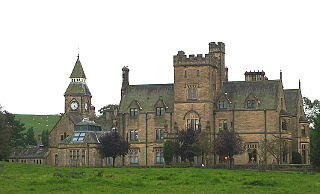
Sedgwick House is located to the west of the village of Sedgwick, Cumbria, England. It was built as a country house, was later used as a school, and then converted into apartments. The house is recorded in the National Heritage List for England as a designated Grade II listed building.

Dalemain is a country house around 5 miles south-west of Penrith in Cumbria, England. It is a Grade I listed building. Dalemain is part of the Lake District UNESCO World Heritage Site.

Millom Castle is an ancient building at Millom in Cumbria. It is a Grade I listed building and scheduled ancient monument.
Beetham is a civil parish in the South Lakeland District of Cumbria, England. It contains 47 listed buildings that are recorded in the National Heritage List for England. Of these, four are listed at Grade I, the highest of the three grades, four are at Grade II*, the middle grade, and the others are at Grade II, the lowest grade. The parish contains the villages of Beetham, Farleton and Hazelslack, and the surrounding countryside. The Lancaster Canal passes through the parish, and the listed buildings associated with this are bridges, an aqueduct and a milestone. Most of the listed buildings in the parish are houses, some of them originally tower houses, and associated structures, farmhouses and farm buildings. The other listed buildings consist of a church, bridges, a former corn mill, milestones and a milepost, boundary stones and a boundary post, a former school, a signal box, and a war memorial.



















